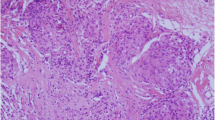Abstract
Clinical examination of the skin lesions, thickened peripheral nerves, demonstration of acid-fast bacilli (AFB) in slit-skin smear (SSS), and histopathology are the steps used for diagnosis of leprosy. Classical techniques used in research include Ziehl–Neelsen staining in SSS or nasal swab, Fite–Faraco staining of biopsy, and anti-phenolic glycolipid I (PGLI) antibodies, to which have been added modern techniques from molecular biology. However, whichever technique is used, the rule that only accurate sampling produces a reliable result should not be forgotten.
Access this chapter
Tax calculation will be finalised at checkout
Purchases are for personal use only
Similar content being viewed by others
References
Sengupta U (2000) Experience and lessons from the use of lepromin and Mycobacterium leprae-specific serology. Lepr Rev 71(Suppl):S63–S66
Kang TJ, Kim SK, Lee SB, Chae GT, Kim JP (2003) Comparison of two different PCR amplification products (the 18-kDa protein gene vs. RLEP repetitive sequence) in the diagnosis of Mycobacterium leprae. Clin Exp Dermatol 28:420–424
Rastogi N, Goh KS, Berchel M (1999) Species-specific identification of Mycobacterium leprae by PCR-restriction fragment length polymorphism analysis of the hsp65 gene. J Clin Microbiol 37:2016–2019
Jamil S, Keer JT, Lucas SB, Dockrell HM, Chiang TJ, Hussain R, Stoker NG (1993) Use of polymerase chain reaction to assess efficacy of leprosy chemotherapy. Lancet 342:264–268
Truman RW, Andrews PK, Robbins NY, Adams LB, Krahenbuhl JL, Gillis TP (2008) Enumeration of Mycobacterium leprae using Real-Time PCR. PLoS Negl Trop Dis. 2(11):e328
Guidelines for Global Surveillance of Drug Resistance in leprosy (WHO 2009)
Matsuoka M (2010) Drug resistance in leprosy. Jpn J Infect Dis 63(1):1–7
Leiker DL, McDougall AC (1987) Technical Guide for Smear Examination for Leprosy (2nd revised edition). German Leprosy Relief Association, Würzburg
Sayer J, Gent R, Jesudasan K (1987) Are bacterial counts on slit-skin smears in leprosy affected by preparing slides under field conditions? Lepr Rev 58:271–278
Bhatia VN, Cherian E, Harikrishnan S (1988) Auramine staining in detecting small number of bacilli in skin smears. Indian J Lepr 60(1):13–16
Author information
Authors and Affiliations
Corresponding author
Editor information
Editors and Affiliations
Rights and permissions
Copyright information
© 2012 Springer-Verlag Italia
About this chapter
Cite this chapter
Clapasson, A., Canata, S. (2012). Laboratory Investigations. In: Nunzi, E., Massone, C. (eds) Leprosy. Springer, Milano. https://doi.org/10.1007/978-88-470-2376-5_8
Download citation
DOI: https://doi.org/10.1007/978-88-470-2376-5_8
Published:
Publisher Name: Springer, Milano
Print ISBN: 978-88-470-2375-8
Online ISBN: 978-88-470-2376-5
eBook Packages: MedicineMedicine (R0)




